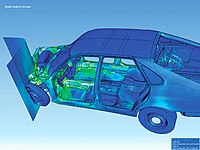
Photo from wikipedia
Abstract In this study, a general higher-order 1-D theory and its finite element model are presented to analyze the large deformation of thin or thick curved rods or pipes like… Click to show full abstract
Abstract In this study, a general higher-order 1-D theory and its finite element model are presented to analyze the large deformation of thin or thick curved rods or pipes like 3-D structure, which have a space curve as their central axis. The material of these structures is assumed to be that of an incompressible neo-Hookean solid. The displacement field of the cross-section perpendicular to the reference curve is approximated by a rather general approximation function in the polar coordinate system in the cross-sectional plane. The governing equation for the presented theory is obtained in terms of the displacement variables referred to the general curvilinear cylindrical coordinate system. The incompressibility condition is included either by the Lagrange multiplier method or the penalty method through the weak-form finite element model. Several numerical examples are presented to illustrate the application of the theory and its finite element model to analyze curved pipes or other tubular shell structures. The numerical results have been compared with the exact solution (where possible) and numerical solutions obtained with shell finite elements or 3D finite elements of the same problems. The present results are remarkably close to those obtained with the 3-D or shell finite elements, while requiring substantially less computational time.
Journal Title: International Journal of Solids and Structures
Year Published: 2019
Link to full text (if available)
Share on Social Media: Sign Up to like & get
recommendations!